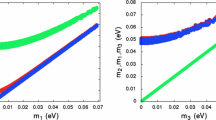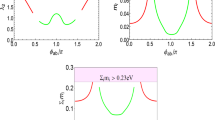Abstract
In 2004, two us proposed a texture, the “Simplest” neutrino mass matrix, which predicted \( \sin {\theta_{13 }}=\sqrt{{{{{2\varDelta m_{{^{sol}}}^2}} \left/ {{3\varDelta m_{{^{atm}}}^2}} \right.}}} \) and δ CP = 90°. Using today’s measured values for neutrino mass-squared differences, this prediction gives \( {\sin^2}2{\theta_{13 }}\simeq 0.086_{-0.006}^{+0.003 } \), compared with a measured value, found by averaging the results of the Daya Bay and RENO experiments, of sin22θ 13 = 0.093 ± 0.010. Here we present a specific model based on S 4 symmetry leading to this successful texture in the context of the type-1 see-saw mechanism, assuming Majorana neutrinos. In this case, slightly different predictions are obtained relating θ 13 to the light neutrino masses, which are in accord with current experimental limits and testable at future experiments. Large CP asymmetries remain a generic prediction of the texture.
Similar content being viewed by others
References
P. Harrison, D. Perkins and W. Scott, Tri-bimaximal mixing and the neutrino oscillation data, Phys. Lett. B 530 (2002) 167 [hep-ph/0202074] [INSPIRE].
DAYA-BAY collaboration, F. An et al., Observation of electron-antineutrino disappearance at Daya Bay, Phys. Rev. Lett. 108 (2012) 171803 [ar**v:1203.1669] [INSPIRE].
RENO collaboration, J. Ahn et al., Observation of reactor electron antineutrino disappearance in the RENO experiment, Phys. Rev. Lett. 108 (2012) 191802 [ar**v:1204.0626] [INSPIRE].
T2K collaboration, K. Abe et al., Indication of electron neutrino appearance from an accelerator-produced off-axis muon neutrino beam, Phys. Rev. Lett. 107 (2011) 041801 [ar**v:1106.2822] [INSPIRE].
DOUBLE-CHOOZ collaboration, Y. Abe et al., Indication for the disappearance of reactor electron antineutrinos in the Double CHOOZ experiment, Phys. Rev. Lett. 108 (2012) 131801 [ar**v:1112.6353] [INSPIRE].
MINOS collaboration, P. Adamson et al., Improved search for muon-neutrino to electron-neutrino oscillations in MINOS, Phys. Rev. Lett. 107 (2011) 181802 [ar**v:1108.0015] [INSPIRE].
G. Altarelli and F. Feruglio, Discrete flavor symmetries and models of neutrino mixing, Rev. Mod. Phys. 82 (2010) 2701 [ar**v:1002.0211] [INSPIRE].
P. Harrison and W. Scott, Symmetries and generalizations of tri-bimaximal neutrino mixing, Phys. Lett. B 535 (2002) 163 [hep-ph/0203209] [INSPIRE].
P. Harrison and W. Scott, μ-τ reflection symmetry in lepton mixing and neutrino oscillations, Phys. Lett. B 547 (2002) 219 [hep-ph/0210197] [INSPIRE].
P. Harrison and W. Scott, Permutation symmetry, tri-bimaximal neutrino mixing and the S 3 group characters, Phys. Lett. B 557 (2003) 76 [hep-ph/0302025] [INSPIRE].
Z.-z. **ng, Nearly tri bimaximal neutrino mixing and CP-violation, Phys. Lett. B 533 (2002) 85 [hep-ph/0204049] [INSPIRE].
P. Harrison and W. Scott, The simplest neutrino mass matrix, Phys. Lett. B 594 (2004) 324 [hep-ph/0403278] [INSPIRE].
H.S.M. Coxeter and W.O.J. Moser, Generators and relations for discrete groups, Springer-Verlag, Germany (1972).
H. Ishimori et al., Non-abelian discrete symmetries in particle physics, Prog. Theor. Phys. Suppl. 183 (2010) 1 [ar**v:1003.3552] [INSPIRE].
C. Lam, The unique horizontal symmetry of leptons, Phys. Rev. D 78 (2008) 073015 [ar**v:0809.1185] [INSPIRE].
F. Bazzocchi, L. Merlo and S. Morisi, Fermion masses and mixings in a S 4 -based model, Nucl. Phys. B 816 (2009) 204 [ar**v:0901.2086] [INSPIRE].
W. Grimus, L. Lavoura and P. Ludl, Is S 4 the horizontal symmetry of tri-bimaximal lepton mixing?, J. Phys. G 36 (2009) 115007 [ar**v:0906.2689] [INSPIRE].
R.-Z. Yang and H. Zhang, Minimal seesaw model with S 4 flavor symmetry, Phys. Lett. B 700 (2011) 316 [ar**v:1104.0380] [INSPIRE].
F. Bazzocchi and L. Merlo, Neutrino mixings and the S 4 discrete flavour symmetry, Fortschr. Phys. 61 (2013) 571 [ar**v:1205.5135] [INSPIRE].
S.F. King and C. Luhn, Trimaximal neutrino mixing from vacuum alignment in A4 and S4 models, JHEP 09 (2011) 042 [ar**v:1107.5332] [INSPIRE].
G. Altarelli, F. Feruglio, L. Merlo and E. Stamou, Discrete flavour groups, θ 13 and lepton flavour violation, JHEP 08 (2012) 021 [ar**v:1205.4670] [INSPIRE].
W. Rodejohann and H. Zhang, Simple two parameter description of lepton mixing, Phys. Rev. D 86 (2012) 093008 [ar**v:1207.1225] [INSPIRE].
S.F. King and C. Luhn, A 4 models of tri-bimaximal-reactor mixing, JHEP 03 (2012) 036 [ar**v:1112.1959] [INSPIRE].
D. Meloni, Bimaximal mixing and large θ 13 in a SUSY SU(5) model based on S 4, JHEP 10 (2011) 010 [ar**v:1107.0221] [INSPIRE].
S.F. King, C. Luhn and A.J. Stuart, A grand Δ(96) × SU(5) flavour model, Nucl. Phys. B 867 (2013) 203 [ar**v:1207.5741] [INSPIRE].
Y. Lin, Tri-bimaximal neutrino mixing from A 4 and θ 13 ~ θ C, Nucl. Phys. B 824 (2010) 95 [ar**v:0905.3534] [INSPIRE].
S. Morisi, K.M. Patel and E. Peinado, Model for T2K indication with maximal atmospheric angle and tri-maximal solar angle, Phys. Rev. D 84 (2011) 053002 [ar**v:1107.0696] [INSPIRE].
Y. Ahn, S. Baek and P. Gondolo, Simple renormalizable flavor symmetry for neutrino oscillations, Phys. Rev. D 86 (2012) 053004 [ar**v:1207.1229] [INSPIRE].
Y. Ahn and S.K. Kang, Non-zero θ 13 and CP-violation in a model with A 4 flavor symmetry, Phys. Rev. D 86 (2012) 093003 [ar**v:1203.4185] [INSPIRE].
A.Y. Smirnov, Seesaw enhancement of lepton mixing, Phys. Rev. D 48 (1993) 3264 [hep-ph/9304205] [INSPIRE].
S. Riemer-Sorensen et al., The WiggleZ dark energy survey: cosmological neutrino mass constraint from blue high-redshift galaxies, Phys. Rev. D 85 (2012) 081101 [ar**v:1112.4940] [INSPIRE].
Author information
Authors and Affiliations
Corresponding author
Rights and permissions
About this article
Cite this article
Krishnan, R., Harrison, P.F. & Scott, W.G. Simplest neutrino mixing from S 4 symmetry. J. High Energ. Phys. 2013, 87 (2013). https://doi.org/10.1007/JHEP04(2013)087
Received:
Revised:
Accepted:
Published:
DOI: https://doi.org/10.1007/JHEP04(2013)087




